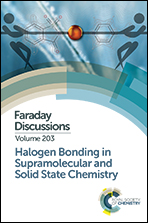The 15N NMR chemical shift in the characterization of weak halogen bonding in solution†
Abstract
We have studied the applicability of 15N NMR spectroscopy in the characterization of the very weak halogen bonds of nonfluorinated halogen bond donors with a nitrogenous Lewis base in solution. The ability of the technique to detect the relative strength of iodine-, bromine- and chlorine-centered halogen bonds, as well as solvent and substituent effects was evaluated. Whereas computations on the DFT level indicate that 15N NMR chemical shifts reflect the diamagnetic deshielding associated with the formation of a weak halogen bond, the experimentally observed chemical shift differences were on the edge of detectability due to the low molar fraction of halogen-bonded complexes in solution. The formation of the analogous yet stronger hydrogen bond of phenols have induced approximately ten times larger chemical shift changes, and could be detected and correlated to the electronic properties of substituents of the hydrogen bond donors. Overall, 15N NMR is shown to be a suitable tool for the characterization of comparably strong secondary interactions in solution, but not sufficiently accurate for the detection of the formation of thermodynamically labile, weak halogen bonded complexes.
- This article is part of the themed collection: Halogen Bonding in Supramolecular and Solid State Chemistry


 Please wait while we load your content...
Please wait while we load your content...